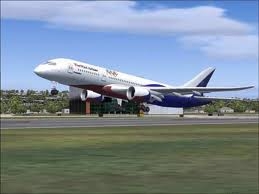Small airlines look to wing it to bigger market shares
 “Air Mekong will begin exploiting Airbus A320 on routes between Hanoi, Ho Chi Minh City and Danang from December 2012,” said the private carrier’s chairman Doan Quoc Viet.
“Air Mekong will begin exploiting Airbus A320 on routes between Hanoi, Ho Chi Minh City and Danang from December 2012,” said the private carrier’s chairman Doan Quoc Viet.
If this came true, Air Mekong would govern a fleet of six planes with four Bombardier CRJ900 aircraft it leased from US-based SkyWest Airlines in August 2010. Each such aircraft can carry 90 passengers whereas an A320 can transport 180 passengers and is ideal to fly medium routes currently strongly exploited by leading state carrier Vietnam Airlines.
Earlier, with its flexible CRJ900 jet fleet Air Mekong established a firm position on sea-island routes and routes between Central Highlands and central region.
The carrier now operates an average 30 flights each day on 13 routes to nine inbound locations. In the past two years, it handles around 20,000 safe flights transporting more than 1.3 million passengers.
Air Mekong eyed 10-12 per cent year-on-year revenue growth in all routes since its debut two years ago, according to Viet. This impressive business figures led to local banker Eximbank’s decision to acquire 11 per cent stake in the airline in early June 2012.
Industry players assumed Air Mekong’s flying main routes, including golden route Hanoi-Ho Chi Minh City was the best way for it to expand market share.
In fact, initial success of low-cost airline VietJetAir with its Airbus A320 fleet was reportedly the reason behind Air Mekong’s recent move to foster presence on major routes for bigger market slice.
VietJetAir’s robust market entry has hurt Vietnam Airlines’ Hanoi-Ho Chi Minh City and Ho Chi Minh City-Danang routes. From its launch in late 2011, VietJetAir won customer affection thanks to its young cabin crew team and competitive pricing.
The budget carrier is flying five routes linking major destinations Ho Chi Minh City, Hanoi, Danang and Nha Trang and envisages launching a new route to Haiphong port city from October, to Phu Quoc island from December 2012 and flying outbound in the forthcoming months.
In the face of strong competition, Vietnam Airlines’ market share had slid from 77 per cent in late 2011 to 74.4 per cent in late May 2012 and is forecast to fall further to 72.6 per cent in late 2012.
Civil Aviation Administration of Vietnam deputy chief Lai Xuan Thanh had attributed Air Mekong and VietJetAir initial success to their well-conceived investment and quality service packages.
“Consumers are the main beneficiaries in a highly competitive market,” said Thanh.
What the stars mean:
★ Poor ★ ★ Promising ★★★ Good ★★★★ Very good ★★★★★ Exceptional
Related Contents
Latest News
More News
- Global partnerships key to Vietnam’s IFC development (December 26, 2025 | 16:18)
- Vingroup pulls out of bid to invest in North-South high-speed railway (December 26, 2025 | 11:42)
- Strengthening supply chains through trade promotions and customs reform (December 24, 2025 | 14:00)
- PM orders investment model for North–South high-speed rail (December 22, 2025 | 17:43)
- LS Eco Energy to invest in Vietnam rare earth sector (December 22, 2025 | 17:31)
- Government moves to establish International Financial Centre (December 21, 2025 | 21:00)
- Vietnam's IFC to target global investment flows (December 21, 2025 | 18:00)
- Two national hospitals expand capacity with new facilities (December 20, 2025 | 09:00)
- Ha Tinh breaks ground on major Vingroup industrial and energy projects (December 19, 2025 | 18:24)
- EVN launches major power infrastructure projects nationwide (December 19, 2025 | 18:17)

 Tag:
Tag:





















 Mobile Version
Mobile Version